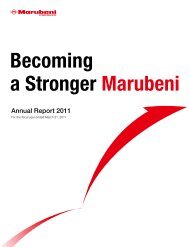Trust Recovery Growth Vitalization - Marubeni
Trust Recovery Growth Vitalization - Marubeni
Trust Recovery Growth Vitalization - Marubeni
You also want an ePaper? Increase the reach of your titles
YUMPU automatically turns print PDFs into web optimized ePapers that Google loves.
Notes to Consolidated Financial Statements<br />
<strong>Marubeni</strong> Corporation<br />
Years ended March 31, 2005 and 2004<br />
1 Basis of Financial Statements<br />
<strong>Marubeni</strong> Corporation (the “Company”), a Japanese corporation,<br />
maintains its books and records and prepares its financial statements<br />
in Japanese yen. The accompanying consolidated financial statements<br />
differ from the non-consolidated financial statements issued<br />
for domestic purposes in Japan. In addition to consolidation, they<br />
reflect certain adjustments not recorded in the Company’s books,<br />
which in the opinion of management are appropriate to present the<br />
Company’s financial position, results of operations, and cash flows in<br />
accordance with accounting principles generally accepted in the<br />
United States. The principal adjustments are: (1) recognition of<br />
installment sales on the accrual basis, (2) recognition of the value<br />
ascribed to warrants, (3) accounting for pension costs, (4) accounting<br />
for certain investments in debt and marketable equity securities,<br />
2 Significant Accounting Policies<br />
Consolidation<br />
The consolidated financial statements of the Company include the<br />
accounts of all majority owned domestic and foreign subsidiaries<br />
(together, the “Companies”). Significant intercompany transactions<br />
and accounts have been eliminated. When a subsidiary sells stock to<br />
unrelated third parties, the Company’s shareholdings in the subsidiary<br />
decreases while the price per share changes, depending on the price<br />
of the new stock issued. The Company recognizes such a change in<br />
the price per share in earnings at the time of the sale of stock.<br />
In January 2003, the Financial Accounting Standards Board (FASB)<br />
issued FASB Interpretation 46, Consolidation of Variable Interest<br />
Entities, an interpretation of ARB No. 51 (FIN 46). In December 2003,<br />
the FASB modified FIN 46 to make certain technical corrections and<br />
address certain implementation issues that had arisen. FIN 46<br />
provides a new framework for identifying variable interest entities<br />
(VIEs) and determining when a company should include the assets,<br />
liabilities, noncontrolling interests and results of activities of a VIE in<br />
its consolidated financial statements. FIN 46 requires a VIE to be<br />
consolidated if a party with an ownership, contractual or other<br />
financial interest in the VIE (a variable interest holder) is obligated to<br />
absorb a majority of the risk of loss from the VIE’s activities, is<br />
entitled to receive a majority of the VIE’s residual returns (if no party<br />
absorbs a majority of the VIE’s losses), or both. A variable interest<br />
holder that consolidates the VIE is called the primary beneficiary. FIN<br />
46 also requires disclosures about VIEs that the variable interest<br />
holder is not required to consolidate but in which it has a significant<br />
variable interest.<br />
The Companies applied FIN46 immediately for the Companies’<br />
interests in VIEs created after January 31, 2003, and for<br />
the Companies’ interests in special purpose entities created<br />
before February 1, 2003 on October 1, 2003. The provisions of<br />
FIN 46, as revised, were adopted as of January 1 2004, for the<br />
Companies’ interests in all VIEs. The adoption of FIN46 did not<br />
have a material impact on the Company’s financial positions and<br />
results of operations.<br />
Certain subsidiaries have been included on the basis of a fiscal<br />
year-end on or after December 31, but prior to the parent company’s<br />
fiscal year-end of March 31. There have been no significant transactions<br />
with such subsidiaries during the intervening periods.<br />
<strong>Marubeni</strong> Corporation 2005 74 / 75<br />
(5) deferred gain on sales of property for tax purposes, (6) accounting<br />
for goodwill and other intangible assets, (7) accounting for derivative<br />
instruments and hedging activities, (8) accounting for sale-leaseback<br />
of real estate and other, and (9) accounting for debt issuance costs.<br />
Certain reclassifications have been made in the 2004 and 2003<br />
financial statements to conform to the presentation for 2005.<br />
The translation of Japanese yen amounts into U.S. dollar<br />
amounts for the year ended March 31, 2005 is included solely for<br />
the convenience of readers outside of Japan and has been made at<br />
¥107 to $1, the exchange rate prevailing on March 31, 2005. The<br />
translation should not be construed as a representation that the<br />
Japanese yen amounts could be converted into U.S. dollars at this<br />
or any other rate.<br />
Use of estimates<br />
The preparation of financial statements in conformity with accounting<br />
principles generally accepted in the United States requires management<br />
to make estimates and assumptions that affect the amounts<br />
reported in the financial statements and accompanying notes.<br />
Although the actual results could differ from those estimates,<br />
management does not believe that any differences would materially<br />
affect the consolidated financial statements of the Company.<br />
Foreign currency translation<br />
Assets and liabilities included in financial statements of foreign<br />
subsidiaries and affiliated companies are translated into Japanese<br />
yen at the respective year end rates. All income and expenses<br />
accounts are translated at the average rates prevailing during the<br />
year. The resulting translation adjustments are included in accumulated<br />
other comprehensive loss.<br />
Foreign currency-denominated receivables and payables are<br />
translated into Japanese yen at the year end rates with the resulting<br />
gains and losses recognized in earnings of the year.<br />
Cash equivalents<br />
The Companies consider deposits in banks and securities purchased<br />
under resale agreements with an original maturity of three months or<br />
less to be cash equivalents.<br />
Investment securities<br />
Management determines the appropriate classification of investment<br />
securities as either trading, held-to-maturity or available-for-sale<br />
securities at the date of purchase.<br />
Trading securities<br />
Trading securities are held for resale in anticipation of short-term<br />
market movements. Trading securities, consisting primarily of<br />
marketable equity securities, are stated at fair value. Gains and<br />
losses are included in gain/loss on sales of investment securities.<br />
Held-to-maturity securities<br />
Debt securities are classified as held-to-maturity when the Companies<br />
have the positive intent and ability to hold the securities to<br />
maturity. Held-to-maturity securities are stated at amortized cost,<br />
adjusted for amortization of premiums and accretion of discounts to



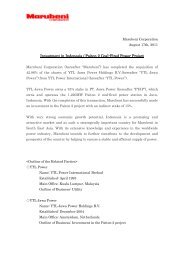
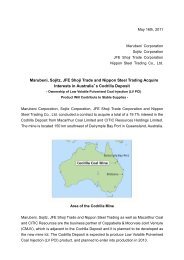
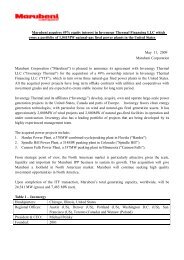

![[Chapter 2] Driving Growth: Expansion Under SG-12 - Marubeni](https://img.yumpu.com/4161147/1/190x248/chapter-2-driving-growth-expansion-under-sg-12-marubeni.jpg?quality=85)
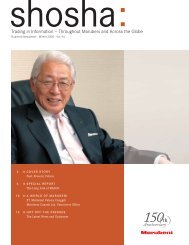

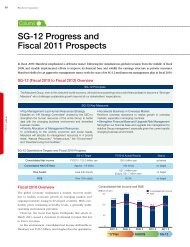

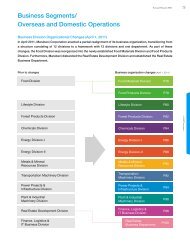
![[Chapter 4] Delivering Growth - Marubeni](https://img.yumpu.com/3464783/1/190x248/chapter-4-delivering-growth-marubeni.jpg?quality=85)
